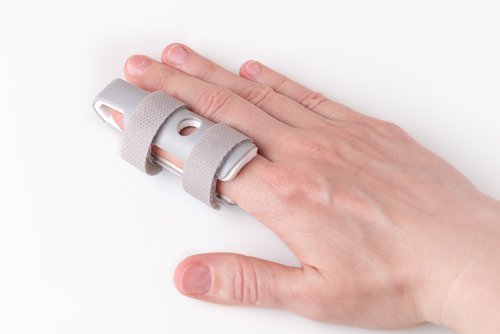
So you’ve smashed your finger performing an everyday task like closing a door, catching a ball, or using a tool. Now you’re in pain, and it doesn’t seem to be going away anytime soon. It’s only natural to start to wonder: is my finger broken?
The physicians at Barrington Orthopedic Specialists treat finger injuries on a regular basis, and many will heal on their own. However, it’s important to know the difference between pain from a temporary jam and a potential fracture that needs immediate medical attention or surgery.
Here are some frequently asked questions about finger fractures that can help you understand your injury:
What Are Some Common Causes Of Broken Fingers?
Your hands are one of the most hardworking parts of your body, which also means they’re one of the easiest parts to injure. Finger fractures often occur as a result of breaking a fall with your hands, catching a ball without proper protection, being careless with power tools and other equipment, and accidentally jamming your finger when closing a door. Additionally, hand injuries are one of the most common workplace injuries in the United States, second only to back injuries.
How Do I Know If My Finger Is Broken?
Whenever you injure your finger, you may feel pain, swelling or stiffness when moving the affected digit. However, there are a few particularly telltale signs that point to a fracture:
- The fracture site is very swollen
- The affected finger appears unnatural or deformed
- The fracture site is tender and bruised
- You have difficulty moving the affected finger completely
If you notice any of these symptoms in your injured finger, it’s time to visit a specialist. Dr. Matthew Bernstein and Dr. Mark Yaffe are experienced hand specialists at Barrington Orthopedic Specialists. To learn more about our physicians, visit our list of providers. We offer an immediate orthopaedic care clinic for urgent needs when our physician’s office is closed.
If My Finger Isn’t Broken, What Might Be Wrong With It?
If you’ve examined your hand and you aren’t showing the symptoms of a fracture, your finger is most likely jammed or sprained. A finger jam can usually be treated with over-the-counter NSAIDs and ice to reduce swelling, though severe sprains may require a splint to ensure the ligaments heal correctly.
It’s also possible that your finger could be dislocated, especially if your finger appears crooked or feels numb. In this case, immediate treatment is needed to evaluate and possibly reduce the dislocation properly. Waiting to treat a dislocated finger can result in long-term difficulties, including loss of movement or sensation.
How Will An Orthopedic Specialist Treat My Finger Fracture?
Luckily, most broken finger bones can be treated without the need for surgery. Your fractured finger may require a splint or cast to protect it from further injury and ensure it heals in the correct position. If your splint also inhibits the fingers next to the one that has been injured, don’t be surprised -- this provides additional support to your broken finger as it heals.
In some cases, including a severe break or a more complex fracture, your doctor may recommend surgical treatment to move your finger bones back where they belong. If you do require surgery, your orthopedic surgeon may use pins, screws, or wires in your finger to hold the bones together from within.
If you’ve injured your finger and you fear it may be broken, schedule an appointment with Dr. Matthew Bernstein or Dr. Mark Yaffe, our hand specialists at Barrington Orthopedic Specialists. Our team of orthopedic hand specialists will get you the quick diagnosis and treatment you need to start recovering now.
For urgent needs when our physician’s office is closed, visit our Immediate Orthopedic Care (IOC) clinic in Schaumburg, Illinois. Have questions? Contact us today.
Frequently Asked Questions
Can I still move my finger if it's fractured?
This can depend on the severity of the fracture. In some cases, individuals may still be able to move their fingers despite a fracture, while in other cases, movement may be significantly limited or painful. It is important to seek medical attention to determine the extent of the injury and receive appropriate treatment and guidance on finger movement during the healing process.
Can I continue to play sports with a fractured finger?
It is generally not recommended to continue playing sports with a fractured finger, as it can increase the risk of further injury and hinder the healing process. It is best to consult with a hand specialist to determine when it is safe to resume sports activities. They can provide guidance on protective measures, such as splints or braces, to support the finger during activity.
Will I need physical therapy after a finger fracture?
Physical therapy may be recommended after a finger fracture, especially for more severe fractures or cases where there is significant stiffness or loss of motion. Physical therapy can help restore strength, flexibility, and function to the finger, aiding in the recovery process. A hand specialist will assess the need for physical therapy and create a customized plan based on individual needs.
What can I do to prevent finger fractures?
To reduce the risk of finger fractures, it is important to take precautions during activities that pose a higher risk of injury, such as wearing protective gloves when using power tools or participating in sports, using proper technique and equipment when playing sports, and practicing good hand safety habits. Additionally, maintaining strong and flexible hand muscles through exercises and stretches can help prevent finger fractures.
What is the treatment for distal phalanx fractures caused by crush injury?
The management of distal phalanx fractures caused by crush injuries depends on the severity of the fracture. In some cases, non-operative treatment methods like splinting or casting may be sufficient. However, more severe fractures may require surgical intervention, which could involve realigning the bones using pins, screws, or wires.
